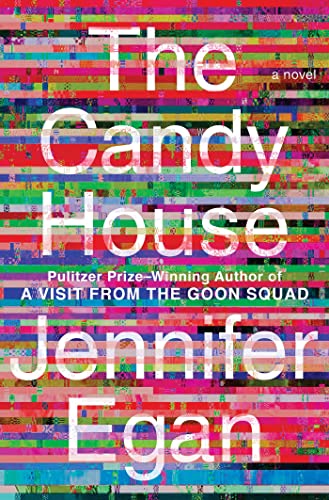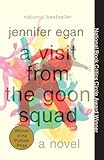“I knew in Goon Squad that Bix would invent social media,” Jennifer Egan says of her character Bix Bouton, who returns from her Pulitzer Prize–winning A Visit from the Goon Squad to take up a central role in her new novel, The Candy House, coming April 5 from Scribner. “When I know something the reader doesn’t know, I know there’s a future story,” she tells me.
The Candy House begins in 2010 with Bix wandering the New York City streets, afraid he will never have a new idea, when he sees a flyer on a lamppost about a discussion group in an apartment near Columbia University following a lecture by anthropologist Miranda Kline. It was Kline’s theories of algorithms explaining trust and influence among members of a Brazilian tribe that Bix adapted to become a very rich and famous tech mogul.
At the meeting, he hears about a scientific experiment to externalize animal consciousness, and 10 years later, Bix has created Own Your Unconscious, a technology that allows users to access the memories of others if they’re willing to share their own. This innovation that develops into a major movement has its detractors, and soon countermovements arise: the “eluders,” who advocate privacy, and the “proxies,” who impersonate them.
Egan presents a group of characters whose lives intersect over generations and tells their stories in a grab bag of forms and styles: letters, tweets, texts, emails. The chapter “Lulu the Spy, 2032” (tweaked from Egan’s story “Black Box,” released in 2012 in a series of tweets and then published in The New Yorker) is a list of mental images: “A woman holding a thrashing baby in one arm may have trouble aiming a firearm with the other.” And, “If you’re lucky, this will buy you time to flee the house.”
Lulu is a character who appeared in Goon Squad as a child; in Candy House she is in her 20s on an espionage mission in the year 2032, somewhere in the Mediterranean.
The sheer imagination, adventure, and majesty of Egan’s writing is impossible to quantify. Quantifying human experience is what Egan says she is circling in Candy House. “We can quantify human experience but where does individuality fit in?” she asks. “We are predictable creatures, yet there’s a marvelous unknowability about us. For all this information, we can’t accurately predict anything. Events still take us by surprise. The paradox is that we know everything.”
Egan admits that, for a couple of years after Goon Squad, which was published by Knopf in 2010, she didn’t write. “I saw the success of Goon Squad as a window of opportunity,” she says, “that was unlikely to happen again.” (It was unlikely to not happen again, I say to myself.) She adds that she decided, “My job now is to ride the wave.”
In 2012, Egan was working simultaneously on Manhattan Beach and Candy House. “I had two rough drafts, writing five pages every day, just writing unconsciously,” she says. “When I realized I had to focus, I chose Manhattan Beach.”
She got back to Candy House in 2017. “I was gathering ideas, making lists,” she says, “trying to draw borders around a certain set of ideas. Why not an epistolary chapter? And I was still interested in the people in Goon Squad.” The big conundrum, she recalls, was, “I didn’t want this to be another Goon Squad. I had to tell a different story in a different way so it would feel like more rather than less.”
Egan thought that if she “couldn’t meet her objective,” she would just write a short piece, but she “began to feel a bigger story,” she says. “What we invent is so extraordinary. We dream literary creations, transform them into symbolic texts. To me that’s what fiction writing is.”
“Fiction” she continues, “is a collective dream life of the culture that makes it. It gives us what nothing else can. My job is to turn raw material into literature. I like to take characters from the natural world and stylize them, like Lulu, to turn the natural world into stylized storytelling.”
After Manhattan Beach, Egan worked exclusively on Candy House, handing in the manuscript in fall 2020. “I use a lot of readers,” she says. (Candy House is dedicated to her writing group.) “I don’t trust myself enough; I like the rigor of the feedback. It forces me to push to do the very best I can.”
Egan says she is surprised at how optimistic Candy House reads. “The fate of the characters from Good Squad—they didn’t turn out so bad. There’s a terror of where we are going, but I ended up writing a book that reminded me of how ingenious humans are. We can do it. Look how fast we came up with a Covid vaccine. Human beings can pull off a lot. The question is, will we?”
Scribner publisher Nan Graham, who became Egan’s editor with Manhattan Beach, concurs: “On top of imagining a frightening future, her characters have such love; between parents and children, brothers and sisters, spouses. It makes you feel equipped to face the future,” Graham says. “There’s a solace in this book. She humanizes the terror of the future so you can bear it. She’s dazzlingly intellectual in terms of imagination and she’s also empathic.”
Graham unabashedly calls Egan “a genius” and “a noble citizen of the literary world,” noting, “We often equate experimental with difficult, but this book is 100 precent accessible. Jenny pushes the forms of fiction, but ultimately she’s a storyteller.”
Graham has known Egan for more than 30 years. “We have very close friends in common,” she says, adding that when Egan and Siddhartha Mukherjee (The Emperor of All Maladies) both won Pulitzers in 2011, they were “twinned” at many award events. “They even had a joint party that spring,” Graham tells me. “There was a real bonding of the three of us.”
ICM Partners literary agent Amanda “Binky” Urban moved Egan to Scribner with Manhattan Beach in a 2012 two-book deal for North American rights. There was no auction. “We knew about this second book,” Graham says. “Jennifer called it a ‘sibling book’ to Goon Squad. Minor characters in Goon Squad moved center stage; main characters became peripheral.”
“She’s at the top of her game,” Graham says. “She believes in the intelligence of the reader. She challenges you, but engages you. And the book is funny—laugh out loud in places.”
Graham wraps up our conversation with a threat: “You’d better have me saying an intelligent quote about this book,” she says, adding, “Jenny is one of the three most important writers of our time.”
Who are the other two? I want to know. But Nan’s not telling.
Bonus Links:
Novelist-of-the-Future: A Profile of Jennifer Egan
Ah, The Children: Jennifer Egan’s ‘A Visit From the Goon Squad’
A Year in Reading 2011: Jennifer Egan
A Year in Reading 2009: Jennifer Egan
This piece was produced in partnership with Publishers Weekly.














